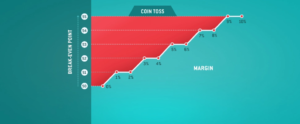The profitability of sports betting and margin impact
Do you know what a ‘margin’ is, and how important is profitability for your sports betting? The greater the turf accountant’s margin, the more likely it is that you have to be in your bets to make a profit over the long term.
Best Odds & Margin
Essentially the margin is also known as a betting odds or market percentage-is the extra value over 100 percent indicated by the odds on any of an event’s similarly exclusive outcomes.
As an example, let’s use a fair dice toss. — outcome (number) has the same probability (1/6) of occurring. So any £1 bet put on rolling a ‘3’ will return £600 (including your £100 stake), for example.
In this case, the decimal odds are 1/probability = 1/(1/6) = 6.00, while its corresponding odds on the moneyline are + 500.
A betting business wants to make a profit, though, and will thus give odds of 5 instead of 6, which doesn’t reasonably represent the implied likelihood. In six dice tosses, it’s predicted the number should come up once. So if you staked £6 but got £5, the bookmaker is making £1 in income.
It is important to remember that, in reality, streaks are attainable.
The implied possibility per result is 20% in this scenario. However, if you average all six results, the number of probabilities will be 120% (6 results x 20% per result). The variance is the difference between the 100 percent and the number of possibilities. It is 20%, in this case, in favor of the turf accountant.
How margins affect bets?
Typically, the higher the turf accountant’s margin, the greater the impact that it would have on your sports betting.
In the example given above, at 5.00 odds, the bettor must make 20% of the accurate guesses of the result. To break even, the bettor will have to make 20/100 correct guesses.
Hence, turf accountant with a 20% margin, the bettor will have to estimate three additional dice rolls correctly. If there is no margin, the bettor would have to make 17 correct guesses (1/6 over 100).
Let’s look now at the break-even point with different margins to show how this affects the profitability of sports betting. We used two
examples-a coin flip, a dice roll, an event with a 90% probability of occurrence, and an unusual incident with a 10% chance with over 100 simulations each tested.
For a coin-toss, the equal chances on either result will be 2.00. In this case, bettors will need to break-even by making 50 correct guesses. If the margin were 5%, then the chances would be 1.904.
In this case, 53 out of 100 guesses are needed to break-even. The graphs below all show a similar pattern that can be proved mathematically, the higher the bookmaker margin, the more accurate bets a bettor has to make.

What did you learn?
Bettors try to maximize their returns in all long-term strategies by attaining the highest possible odds. The higher the margin, the lower the chances and, to recompense this, it is required to raise the bettor’s successful guesses in order to accomplish break-even.
A rise is simply a round number of the margin compounded by the break-even if the margin was 0. For instance, in a coin toss, if the margin was 0, the break-even is 50 guesses. When a 3% margin is applied, the change is 3 percent of 50, which is 1.5, which is rounded to 2.
Therefore, if the margin were 3%, 52 guesses would be needed. Popular sports markets are provided as low as 2%, compared to the market average of 5%, which leads to a higher value.
It has shown you how important the competitiveness of sports betting margins are. The higher the margin, the more accurate the bets have to be to succeed in the long run.





